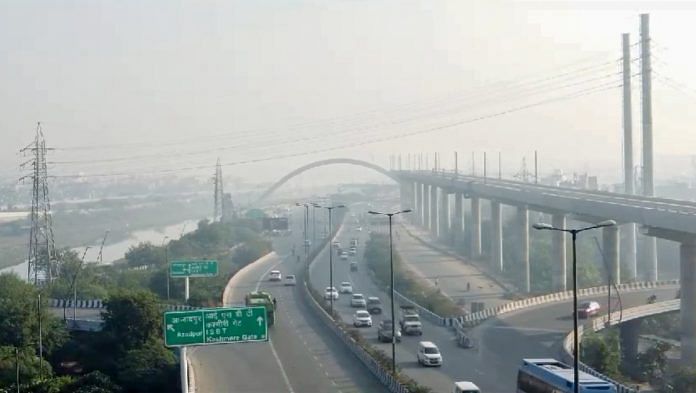A noxious fog of air pollution is back in the lives of Indians, or at least those in the Indo-Gangetic belt. We all agree that the toxic air has devastating consequences for our health and well-being and that something must be done. But what has not been acknowledged enough is that the solution requires overhauling the various sources of pollution and that this won’t come cheap.
There is a cost that will have to be borne for the transition to a cleaner environment. India has been gearing up to think about climate finance as it transitions to net-zero emissions — the costs of pollution abatement need to be integrated into this strategy.
For this to happen, India must take a clear view of the scale of the problem as well as the financial resources it will take to address it.
Also Read: Let states receive global capital. They can’t achieve net zero on their own
Big problem, big numbers
Financing the transition to a cleaner environment has to take into account three realities.
First, air pollution is not a Delhi phenomenon. The entire Indo-Gangetic belt is enveloped in smog in the winter months. The extent of the problem is thus much greater than the headlines would have us believe.
Second, air pollution is not only about PM2.5. Other pollutants such as PM10, S02, NOx, and CO2 are just as damaging to human health. Any strategy to reduce pollution has to factor in all these pollutants.
Finally, pollutants come from many sources— including crop burning, vehicular emissions, road and construction dust, industrial emissions, and coal-fired electricity plants. Each activity emits large amounts of pollutants. It is not useful to focus on just one source while ignoring others. One needs an approach that deals with all of the sources across a large geographical area and includes an estimate of the cost of the transition to cleaner technologies.
Let’s take the example of vehicular pollution. It requires an upgradation of fuel standards and investments in improving public transport.
India has adopted Bharat Stage VI emissions standards for all vehicles manufactured after March 2020. The shift to higher standards has cost about Rs 60,000 crore already. Much of this burden will be passed on to customers over a period of time.
According to some estimates, diesel car prices are likely to go up by more than Rs 1 lakh with the new standards. There is also a considerable push toward electric vehicles (EVs). The initiative to deploy 10,000 electric buses across cities has cost us Rs 57,613 crore.
There are similar costs involved in reducing crop burning by farmers or dealing with construction dust in our cities.
Reducing pollution from power plants would require the installation of emission control technologies and a shift to renewables such as solar and wind energy.
Navigating such a transition may not be simple. For example, while the shift to EVs might reduce vehicular emissions in the cities, they might increase carbon emissions near thermal power plants. To decrease emissions from diesel generators, the reliability of power supply must be improved, which, in turn, requires an upgrade of traditional distribution utilities.
Also Read: Quit stalling & pay up — what’s climate finance and why rich countries must step up urgently
Transition finance
India has taken some action to lower air pollution through fiscal measures.
In 2020, finance minister Nirmala Sitharaman allocated Rs 4,400 crore for the National Clean Air Programme (NCAP). The plan provides an incentive for cities with a million-plus population to reduce pollution levels by 15 per cent every year. However, this will not be enough.
There may be a case for India to access international finance for its air pollution transition, similar to its approach to climate transition. For example, India has integrated green bonds into its climate finance strategy, issuing the first tranche of its first sovereign green bond, worth Rs 8,000 crore in January 2023.
Other facilities such as the Global Environment Facility (GEF), the Special Climate Change Fund (SCCF), the Least Developed Countries Fund (LDCF), and the Adaptation Fund (AF) help with the climate transition too. Private sector investment also presents multiple channels toward achieving our climate goals.
It is important to identify areas where there is an intersection between air pollution and climate. For instance, shifting away from coal-fired power plants to renewables, or at least upgrading coal plants, are important elements of India’s net-zero trajectory. But these measures also have a bearing on the air pollution abatement strategy.
By considering the synergies between air pollution and climate mitigation, both challenges can be addressed more efficiently.
The air pollution transition plan must encompass the entire spectrum of human and industrial activity. This is not going to be cheap and will disrupt existing structures of production and livelihoods. This is not to say that it must not be done, but careful accounting of the transition costs will help in making feasible plans that will actually deliver over a period of time.
The shift toward a low-pollution India will not happen without the necessary financial arrangement.
Renuka Sane is research director at TrustBridge, which works on improving the rule of law for better economic outcomes for India. She tweets @resanering. Views are personal.
(Edited by Asavari Singh)



